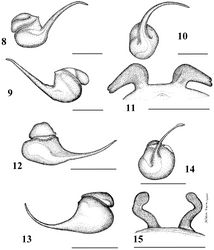Typhochlaena
| Notice: | This page is derived from the original publication listed below, whose author(s) should always be credited. Further contributors may edit and improve the content of this page and, consequently, need to be credited as well (see page history). Any assessment of factual correctness requires a careful review of the original article as well as of subsequent contributions.
If you are uncertain whether your planned contribution is correct or not, we suggest that you use the associated discussion page instead of editing the page directly. This page should be cited as follows (rationale):
Citation formats to copy and paste
BibTeX: @article{Bertani2012ZooKeys230, RIS/ Endnote: TY - JOUR Wikipedia/ Citizendium: <ref name="Bertani2012ZooKeys230">{{Citation See also the citation download page at the journal. |
Ordo: Araneae
Familia: Theraphosidae
Name
Typhochlaena C. L. Koch, 1850 revalidated – Wikispecies link – Pensoft Profile
- Typhochlaena C. L. Koch, 1850:75.
- Avicularia:Simon 1892[1]:171 (in part: Avicularia seladonia).
- Iridopelma: Smith 1993[2]:15 (in part: Iridopelma seladonium).
Type species
Mygale seladonia C. L. Koch, 1841 by subsequent designation (Mello-Leitão 1923[3]:332). Almeida-Santos et al. (2008) stated that Mello-Leitão (1923)[3] “erroneously reestablished Typhochlaena without removing the type species, Typhochlaena caesia C. L. Koch, 1842, from Avicularia”, but they did not indicate where their information on the type species of the genus came from. The genus Typhochlaena was erected by Koch (1850)[4] and originally included two species: Typhochlaena seladonia and Typhochlaena caesia. Neither Koch (1850)[4] nor subsequent authors indicated the type species of Typhochlaena, until Mello-Leitão (1923)[3], who designated Typhochlaena seladonia C. L. Koch, 1841.
Diagnosis
Differs from all other aviculariine genera by the domed, short distal segment of PLS (Fig. 21) and adults with sternum as long as wide, truncated behind (Fig. 20). Additionally, they are very small aviculariines having urticating hair type II on the dorsum of the abdomen and males lack both tibial spurs and spiniform process on the cymbium.
Description
Carapace as long as wide, or slightly longer than wide, cephalic region moderately raised (Fig. 16). Cephalic and thoracic striae shallow. Fovea shallow, straight. Chelicerae without rastellum. Eye tubercle low (Typhochlaena seladonia) (Fig. 18) or raised (other species), wider than long. Clypeus narrow (Figs 18–19). Anterior eye row procurved (Fig. 19). Labium wider than long, with ca. 58–122 cuspules concentrated on anterior half. Maxillary lyra absent. Maxilla subrectangular, anterior lobe distinctly produced into conical process, inner angle bearing (40–69) cuspules. Sternum wider than long or as long as wide, truncated behind (Fig. 20). Posterior angle not separating coxae IV. Three pairs of sigillae, all rounded, less than a quarter diameter from margin, sometimes not evident. Leg formula: IV I II III (except male Typhochlaena amma sp. n.: I IV II III). Clavate trichobothria on the distal 1/2 of tarsi I-IV. STC of males and femalewithout teeth. Tarsi I–III fully scopulated, IV divided by a band of setae. Scopulae of tarsi and metatarsi I–II extended very laterally giving them a spatulate appearance. Femur IV without retrolateral scopula. Legs lacking spines in males, female legs aspinose or with two ventro-apical spines on metatarsi III and/ or IV (Typhochlaena seladonia, Typhochlaena paschoali sp. n.). Posterior lateral spinnerets with distal article short, domed (Fig. 21). Stridulatory setae absent. Cymbium with two subequal lobes, the prolateral one triangular in shape (fig. 25 in West et al. 2008[5]). Male spur on tibia I lacking. Male metatarsus I straight. Male palpal bulb globose narrowing abruptly forming a long slender embolus, 4 times (Typhochlaena seladonia) (Figs 1–3), 1.5 times (Typhochlaena costae sp. n.) (Figs 12–14), or 2.5 times (Typhochlaena amma sp. n.) (Figs 8–10) longer than tegulum length, with a curvature of roughly 60° (Typhochlaena seladonia, Typhochlaena amma sp. n.) (Figs 1–3, 8–10) or 45° (Typhochlaena costae sp. n.) (Figs 12–14) to retrolateral side, keels absent, tegulum with a slight prolateral depression (Typhochlaena seladonia) (Fig. 3), or absent (Typhochlaena costae sp. n., Typhochlaena amma sp. n.) (Figs 10, 14). Two spermathecae extremely variable in shape (Figs 4–7, 11, 15). Cymbium lacking spiniform process. Type II of urticating hair on abdomen dorsum of males and females. Ontogenetic change in color pattern lacking.
Males of Typhochlaena curumim sp. n. and Typhochlaena paschoali sp. n. are unknown.
Species included: Typhochlaena seladonia (Figs 1–5, 16–23), Typhochlaena curumim sp. n. (Figs 6, 26), Typhochlaena paschoali sp. n. (Figs 7, 27), Typhochlaena amma sp. n. (Figs 8–11, 24) and Typhochlaena costae sp. n. (Figs 12–15, 25).
Distribution and habitat
Brazil: Northeastern, part of Central-West (state of Tocantins) and part of Southeastern (state of Espirito Santo) (Fig. 28). Specimens of Typhochlaena spp. are mostly found in Brazilian Atlantic rainforest, but one species seems to occur in drier, open environments (Typhochlaena costae sp. n.). Available data for two species (Typhochlaena seladonia and Typhochlaena curumim sp. n.) indicates they build a silky retreat under loose tree bark (Fig. 23).
Color pattern ontogeny
Contrary to most aviculariines, ontogenetic changes are not known in species of Typhochlaena.
Key to species of Typhochlaena
(Males of Typhochlaena curumim sp. n. and Typhochlaena paschoali sp. n. are unknown)
Taxon Treatment
- Bertani, R; 2012: Revision, cladistic analysis and biogeography of Typhochlaena C. L. Koch, 1850, Pachistopelma Pocock, 1901 and Iridopelma Pocock, 1901 (Araneae, Theraphosidae, Aviculariinae) ZooKeys, 230: 1-94. doi
Other References
- ↑ Simon E (1892) Histoire naturelle des araignées. Paris, 1: 1-256. doi: 10.5962/bhl.title.51973
- ↑ Smith A (1993) Taxonomy focus. Journal of the British Tarantula Society 9: 13-18.
- ↑ 3.0 3.1 3.2 Mello-Leitão C (1923) Theraphosoideas do Brasil. Revista do Museu Paulista 13: 1-438.
- ↑ 4.0 4.1 Koch C (1850) Übersicht des Arachnidensystems. Nürnberg, Heft 5, 1–77.
- ↑ West R, Marshall S, Fukushima C, Bertani R (2008) Review and cladistic analysis of the Neotropical tarantula genus Ephebopus Simon 1892 (Araneae: Theraphosidae) with notes on the Aviculariinae. Zootaxa 1849: 35–58. http://www.mapress.com/zootaxa/2008/f/z01849p058f.pdf
Images
|




